Some birds
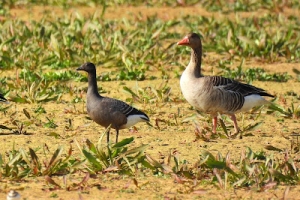
Barnacla carinegra, Branta bernicla. Brent goose.
It is a juvenile individual (first winter) belonging to the nominal subspecies: Branta bernicla bernicla. Although the subspecies that is considered a rarity in the Iberian Peninsula is the Greenlandic Goose, Bernicla hrota, this bird is also rare and more so in these latitudes where it is accidental.
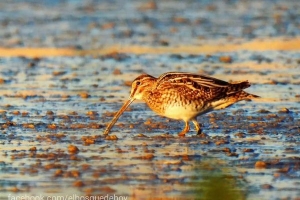
Agachadiza común, Gallinago gallinago, Common snipe.
Huge bill that almost doubles the length of the head. Plunges bill repeatedly like a sewing machine in search of food. During the winter it occupies both coastal and inland areas. Among the latter, he chooses river banks, ponds, lagoons and reservoirs.
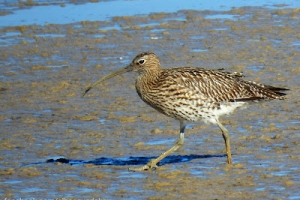
Zarapito real, Numenius arquata, Eurasian curlew.
The largest of our waders. Very long beak, bends the head and with pronounced and uniform curvature. During the winter it occupies, particularly, coastal areas, such as marshes, estuaries and even floodplain meadows.
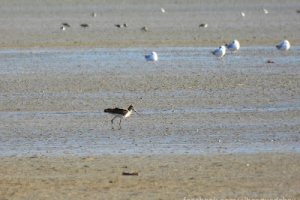
Aguja colinegra, Limosa limosa. Black-tailed godwit.
Common in passage both on the coast and in the interior, unlike the Blacktail.
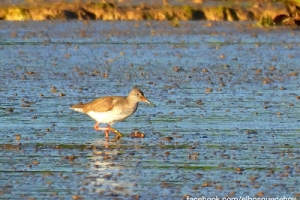
Archibebe común, Tringa totanus. Common redshank.
Throughout the winter it usually frequents inland and coastal aquatic habitats, generally in areas with some vegetation cover, such as the edges of channels, marshes and salt marshes.
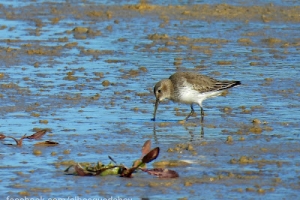
Correlimos común, Calidris alpina. Dunlin.
Throughout the migratory passage and during wintering, it stops at intertidal plains, estuaries, coastal lagoons and even on the shores of inland waters.
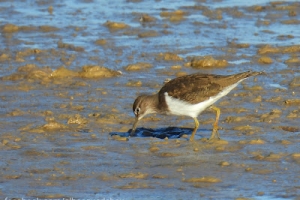
Andarríos chico, Actitis hypoleucos. Common sandpiper.
On the Peninsula it breeds widely in rivers, streams and reservoirs, where it occupies coves, sandy banks and gravel accumulations. In migration and wintering it can also appear in estuaries, marshes, beaches and rocky areas.
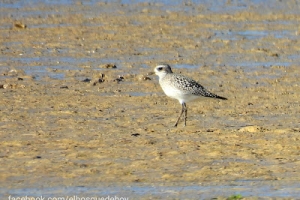
Chorlito gris, Pluvialis squatarola. Grey plover.
Outside the reproductive period, it usually concentrates on beaches with extensive intertidal areas, although it also appears frequently in inland sandy areas, pools and humid places, such as flooded meadows.
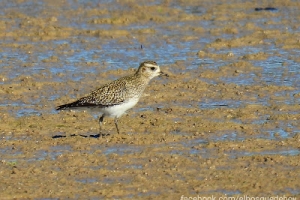
Chorlito dorado europeo, Pluvialis apricaria. European golden plover.
Throughout the migration and in winter it appears, above all, in humid meadows, grasslands with ponds and meadows —very often in the company of lapwings—, inland wetlands, coastal areas and estuaries.
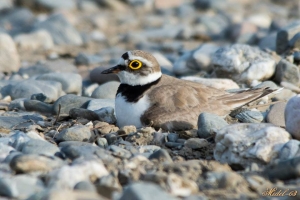
Chorlitejo chico, Charadrius dubius. Little ringed plover.
During the non-breeding period it can be found both on inland muddy shores and on the coast.
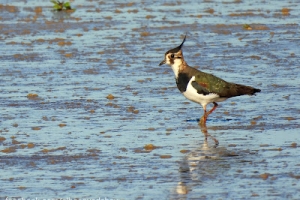
Avefría europea, Vanellus vanellus. Northern lapwing.
During the winter it occupies a greater diversity of open or semi-wooded environments, from marshes and navazos to meadows, wastelands, fallows and pastures.
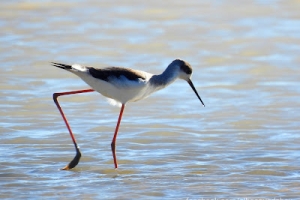
Cigüeñuela común, Himantopus himantopus. Black-winged stilt.
It is a common bird. Summer and in step, although many winter. Wintering is concentrated in the south of the peninsula. This wader usually frequents shallow-water wetlands, which is why it can appear in deltas, estuaries, coastal lagoons, marshy areas, shallow lakes, salt marshes, marshes, seasonal lagoons, and river banks.
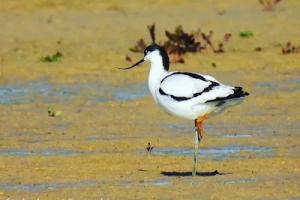
Avoceta común, Recurvirostra avosetta. Pied avocet.
They winter mainly in Andalusia. It occupies shallow and brackish or salty waters, mainly coastlines.
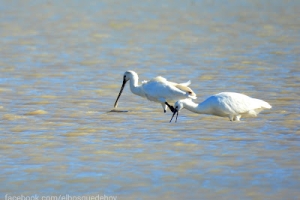
Espátula común, Platalea leucorodia. Eurasian spoonbill.
It prefers shallow wetlands, generally coastal (sometimes inland lagoons and pools) and therefore saline, such as marshes, deltas and estuaries, which have fine sand or mud bottoms and register appreciable tidal changes. In general, it avoids areas with very stagnant or very turbulent waters, as well as lacustrine environments with abundant submerged vegetation.

Morito común, Plegadis falcinellus. Glossy ibis.
During the winter it feeds in rice paddies, ponds and shallow freshwater marshes.
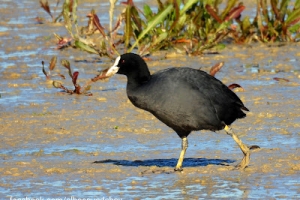
Focha común, Fulica atra. Eurasian coot
It occupies fresh waters (lagoons, reservoirs, lagoons, marshes, slow rivers). Basically sedentary indigenous people. Important wintering, when abundant.
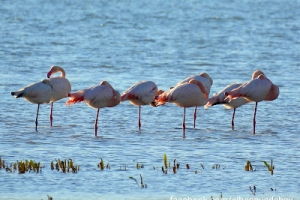
Flamenco común, Phoenicopterus roseus. Greater flamingo.
It requires large areas of shallow water, such as coastal lagoons, marshes, salt flats or large endorheic lagoons, generally with a markedly saline or at least brackish character and often also subject to temporary flooding regimes.
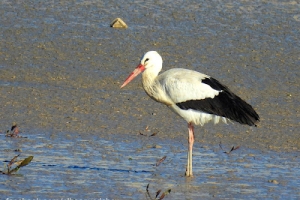
Cigüeña blanca, Ciconia ciconia. White stork.
The white stork is a bird closely linked to man and his productive activities, which is why it preferably occupies open and relatively transformed habitats, such as pastures, irrigated land, pastures rich in livestock, dryland crops, as well as wetlands and natural grasslands. , in which it looks for its food.
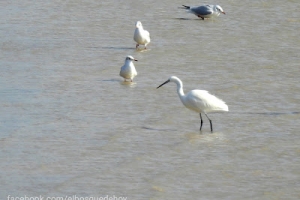
Garceta común, Egretta garzetta. Little egret.
Outside the breeding season —and also when looking for food— it frequents all kinds of natural or artificial wetlands, from floodplains, reservoirs, river backwaters and salt flats to irrigation canals and, especially, rice fields.
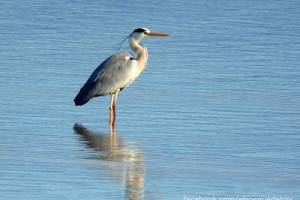
Garza real, Ardea Cinerea. Grey heron.
Rapidly increasing breeding population and thousands of winterers. During the winter and during migratory passages, it is very undemanding and it is common for it to occupy all kinds of wetlands, natural or artificial (rice fields, salt pans, irrigation canals or fish farm ponds), as well as pastures, meadows or beaches.
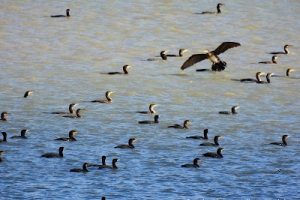
Cormorán grande, Phalacrocorax carbo. Great cormorant.
The only one in inland waters. Wintering population on the rise. It occurs fundamentally as wintering, although for a few years it has begun to breed in some interior reservoirs. It is common during the winter in most of the peninsular provinces, as long as they have large reservoirs, lagoons or rivers with large populations of fish.
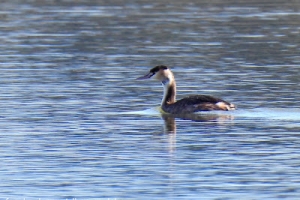
Somormujo lavanco, Podiceps cristatus. Great crested grebe.
In winter, it is more frequent in reservoirs, where sometimes hundreds are concentrated.
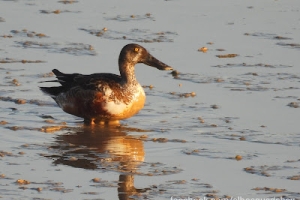
Cuchara común, Anas clypeata. Northern shoveler.
Immature male shoveler filtering water for food. During the winter it is quite frequent in a greater variety of environments (also in marshes and reservoirs).
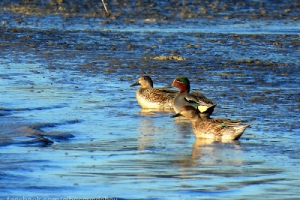
Cerceta común, Anas crecca. Common teal.
During the winter, contrary to the breeding season, it is quite common. When it usually occupies small wetlands, both natural and artificial, with fresh or brackish water, preferably rich in nutrients.

Ánade friso, Mareca strepera. Gadwall.
Relatively demanding as far as the choice of habitat is concerned, the Gaddle usually settles during the breeding season in shallow wetlands, preferably freshwater, with emerged vegetation and islets, while during the winter it frequents lagoons, reservoirs, marshes. and estuaries.
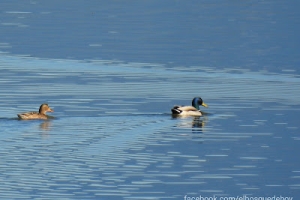
Ánade azulón, Anas platyrhynchos. Mallard.
Extraordinarily generalist bird as far as its environmental needs are concerned, the mallard frequents wetlands of all kinds, such as slow watercourses, marshes, lagoons, reservoirs and even seasonal ponds or ponds in parks and gardens. In any case, it shows a preference for shallow or shallow waters, in which, due to its gregarious habits, it is concentrated in groups of variable size.
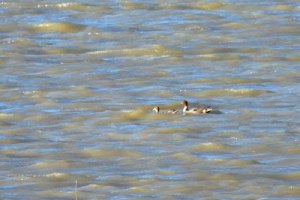
Ánade rabudo, Anas acuta. Northern pintail.
During the winter it is concentrated in coastal habitats or in wetlands close to the coast. Scarce or rare in the interior.
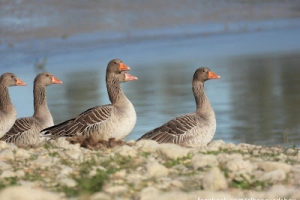
Ánsar común, Anser anser. Greylag goose.
In the Iberian Peninsula, the Greylag Goose is exclusively wintering. During the winter in our country, the Greylag Goose prefers to settle in open and waterlogged areas, such as marshes and shallow lagoons, although in general it can frequent all kinds of shallow waterlogging with low vegetation, as well as reservoirs and rivers that are surrounded by good extensions of cereal crops, rice fields or cornfields.

Tarro blanco, Tadorna tadorna. Common shelduck.
It is closely linked to halophilic habitats, both inland saline lagoons associated with steppe environments and coastal lagoons and salt flats. Even so, its adaptability allows it to settle in reservoirs, irrigation ponds, purification lagoons and even in the marine environment.
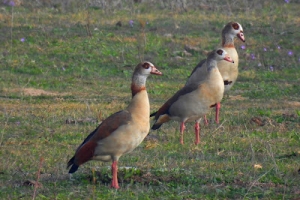
Ganso del Nilo, Alopochen aegyptiaca. Egyptian goose.
Invasive alien species. The sightings are distributed throughout the year, with greater frequency in the middle of winter (December-January) and somewhat less in spring (around April) and autumn (September). This pattern of arrivals, coinciding with the one observed in France, suggests the arrival of specimens from other parts of Europe.
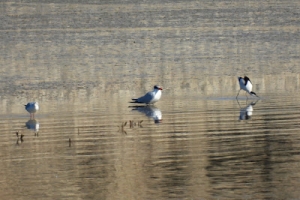
Pagaza piquirroja, Hydropogne caspia. Caspian tern.
In passage and wintering it is observed, always on the coast, in marshes, beaches, lagoons, river mouths, reservoirs and deltas. In the south of the peninsula it preferentially occupies salt flats.
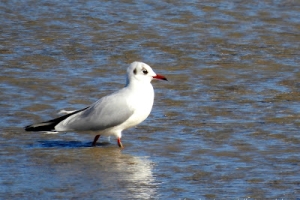
Gaviota reidora, Chroicocephalus ridibundus. Black-headed gull.
During the winter it is a fairly widespread and very common species on our coasts, beaches, fishing ports, rivers or reservoirs, often associated with the existence of landfills, where it forages in large groups.

Gaviota sombría, Larus fuscus. Lesser black-backed gull.
During the winter it is a very common species, both on the coast and in the interior —where it frequents rivers and reservoirs—, often associated with the existence of landfills, where it looks for food.
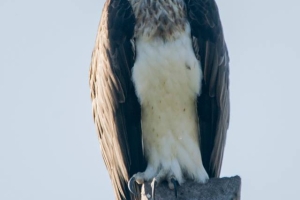
Águila pescadora, Pandion haliaetus. Osprey.
Migratory or wintering individuals appear in various aquatic complexes: bays, inland lagoons, reservoirs, and estuaries.
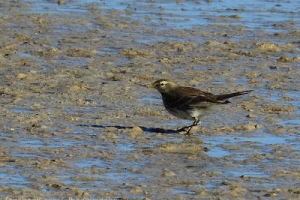
Bisbita alpino, Anthus spinoletta. Water pipit.
In winter it establishes itself in humid places in the valleys and plains at low levels, even at sea level, such as marshes, rice fields, flooded meadows and the banks of ponds, rivers and reservoirs.
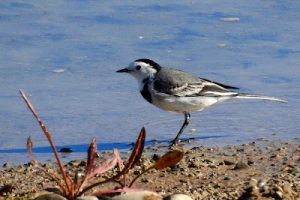
Lavandera blanca, Motacilla alba. White wagtail.
In winter it occupies very varied environments, in many cases with human influence and close to water, such as rivers, streams, ponds, pastures, orchards, irrigated fields and parks.
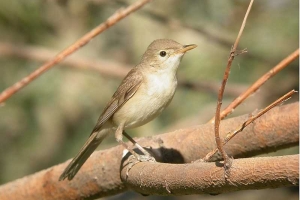
Zarcero bereber, Iduna opaca, Western Olivaceous. Warbler.
Summer species in the province, but also present during its migratory passage and some wintering specimens from the north. Trans-Saharan species that winters in tropical Africa. It reproduces from May.
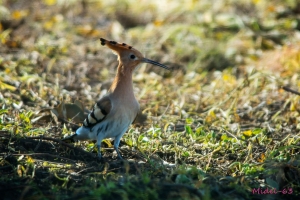
Abubilla, Upupa epops, hoopoe.
The hoopoe is a species of hornbill bird in the Upupidae family; It is a diurnal, solitary, territorial and migratory species.
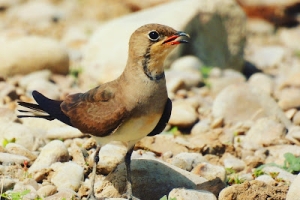
Canastera común, Glareola pratincola.
Apparently, according to this entry from the III Atlas of Birds in the Breeding Season of Spain by SEO/BirdLife, it has ceased to breed in the area. But here was a good group of these birds, with long wings and a deeply forked tail like a great swallow, on the banks of the reservoir on July 12, 2022.
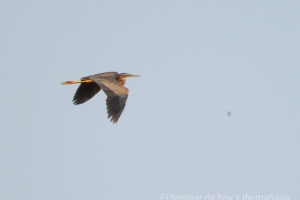
Garza imperial, Ardea purpurea.
Smaller, more graceful and darker than the gray heron, this breeding species in the area according to the aforementioned publication. Photo dated July 12, 2022.
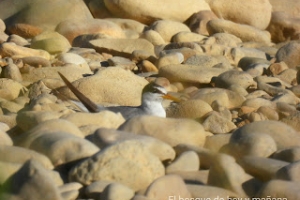
Charrancito común, Sterna albifrons.
New player in the area according to the III Atlas of Birds in the Breeding Season of Spain by SEO/BirdLife. Very small, with yellow beak and legs, white forehead also in summer. Photos from July 27, 2022.
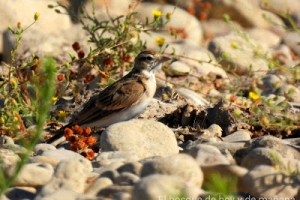
Terrera común, Calandrella brachydactyla.
Breeding species in the area. "Clean" Lark, slightly striated, sandy in color. Photos from July 27, 2022.